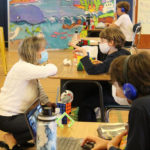
Specialty Spotlight: Serendipity in Science
Sometimes, in the course of teaching my different subjects to different grade levels, I’ll suddenly realize that two totally different areas of study are simultaneously touching upon the same underlying science concept. I guess it’s possible that I’m unconsciously guiding these convergences, but I nevertheless marvel a little bit at the crossing of content strands. Currently, not two, but three such strands are crossing, as 2nd, 5th, and 6th graders all arrive at the idea of density at the same moment!
As 2nd graders prepare for the design challenge of using foil to create boats that will support a given weight, we’ve been discussing flotation in different ways. In one discussion, I had them imagine four equal-sized balloons completely submerged, then released underwater in a swimming pool — one is tied after being filled with air, one with pool water, one with sand, and the last with helium. Balloon by balloon, we considered these questions: Will it move?; Which direction?; Will it stop moving?; Where?; Why? This discussion was followed by the ever-dazzling layering of liquids demonstration. I showed them four liquids and carefully poured each, one at a time, into a test tube. The corn syrup lay on the bottom, and the corn oil (yellower than the syrup) set up camp right on top of it. Next, I poured in some water, which I’d colored blue. Instead of sitting on top, it went through the oil layer and found its place between the two. Red-colored rubbing alcohol, poured in last, was happy to stay above the rest. I’d already prepared an identical test tube that I told them contained the same four liquids. In this one, though, the red layer was second from the bottom, and the blue was on the top. Why? (I never said I had colored the water and alcohol the same!)
Grade 5 students are beginning their Matter and Change unit, an introduction to chemistry. Their first foray into this subject is an investigation into density, itself. Starting with the old puzzler (which some knew and others didn’t), “Which weighs more, a ton of feathers, or a ton of bricks?”, I added the follow-up question, “Which one takes up more room?”. Then we looked at three cubes, each 1 inch on a side. Since one was wood, another metal (aluminum), and the last one sponge, the students knew, intuitively, that their weights should be different. Like other fundamental science principles, density isn’t a terribly complex idea but defies a truly simple wording. I usually end up with something like this: If you have the same amount of two different materials, the one that weighs more is denser. It’s how tightly-packed the matter is.
In 6th grade, the idea of density is being applied to their forensics unit. As we compare four document examples from four suspects to one collected at the crime scene, we try to find differences and similarities between the papers used. Measuring the dimensions of the paper samples, then taking the mass, yields all the information we need to calculate the density of the various samples, and, surprisingly, these results vary enough to easily distinguish differences. Having experienced density before, these students were able to incorporate it into their forensics investigation without pausing for more than a refresher of the concept.
First-principles, like density, are worth taking time with, in the classroom. And they’re worth spiraling back to again and again too since these concepts are the ones that will build the foundations for a general understanding of how to make sense of, and communicate about the world around us.
Chip Edwards, Science Teacher




